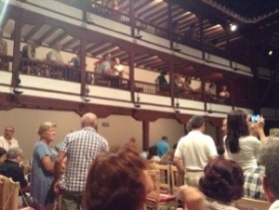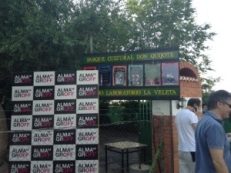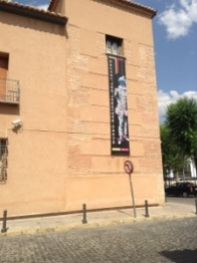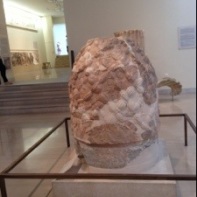SEE THE WORLD AND SEE WORLD THEATRE
Almagro International Festival of Classical Theatre, Almagroff, Golden Age of Spanish Theatre, Fuenteoveojuna by Lopes de Vega, El lindo don Diego by Moreto, Fuentovejuna by Lopes de Vega, the Castile – La Mancha countryside, Almodovar’s village, Caldaza de Calatrava, Volver
This was a wonderful day and almost as if I’d be saving the best till last. In preparation for my drive to Merida tomorrow, I had to go back to Ciudad Real to collect the hire car before 1.30. Once again I headed to the Almagro Estacion and made the 15 minute trip by fast train. As I needed to familiarize myself with right hand side of the road driving, I decided to do a bit of sight seeing before returning to Almagro. I started off in the heat of the day and as I was driving (well getting lost really) around Ciudad Real, I saw a very big market. And the best thing was that it had stall after stall of fruit and vegetables! I left with bags full of goodies.
From the market I went to several special sites including Alacros, a medieval town, military stronghold, which included the Knights Templar Order of Calatrava, and a battlefield, against the Moors. Close by is another historical medieval sacred castle and monastery called Calatrava La Nueva which the Knights of the Calatrava maintained.
Just exploring these places enabled me to contextualise the period of chivalry in this province of Castile-La Mancha that so inspired Cervantes. Looking at the broad, empty landscape (and not a windmill in sight) one can appreciate the journeys of Don Quixote (with his squire, Sancho Panza) and his quest to do right.
Another curiosity is that Calzada de Calatrava, the village at the foot of the castle, is the birthplace of Pedro Almodovar. When he was 8, Almodovar was sent to boarding school in Caceres, Extremadura, which is in the Merida area of Spain. His film,Volver, is based in and around Almagro and I was reminded of the opening scene when each day I noticed the women in Almagro scrubbing the brick work, window sills and pavements of their houses. Of course Almodovar is exceedingly famous now and he lives, and has his production office, in Madrid, but it is interesting to connect any artist to place.
While I was in Caldaza, I stopped in a bar for an ice cream, and there I saw a local Bullfight on TV. I am greatly attracted by the theatricality of Bullfighting and have resolved to go to one. Madrid of course houses the main bullring but as it is a seasonal activity I will need to plan for it on another trip. Although, I’m not averse to a municipal bullfight like the one I saw advertised in Ciudad Real.
Before going to the theatre in the evening, I was able to include a visit to the Museum of Theatre. What I found extraordinary is that the museum is a huge building at the end of the Plaza de Mayor
in a small provincial town. While it may be true that Almagro values the tourist influx associated with its’ festival, I also suggest it is equally true that it also has the greatest respect for its theatre history and the history of theatre in general. This museum focused on theatre memorabilia, ephemera and costumes. And sadly for me, its’ opening at 6 pm meant that I had very little time there before going to catch the bus to Teatro La Valete. This museum is another place to which I’d like to return.
This production Lopes de Vega’s, Fuenteovejuna, was a perfect blending of old text and contemporary adaptation. I am told that it has been in the company’s repertoire for some two years, and that certainly shows in terms of slickness, wonderful ensemble work and a real commitment to telling the story.
Set out of doors on this beautifully balmy evening, the play unfolded with all of the well known elements associated with this piece. Despotism, municipal corruption and abuse of power, community fear, torture on the rack, the ultimate resistance by the community and hubris of the Corregidor was handled in the manner of modern day activism, sort of a class action approach, with appropriate slogans, chanting, a petition and enlistment of supporters, to no avail but a totally concerted agreement by the whole town that ‘Fuenteovejuna made me do it.’
Each actor excelled in representing the various characters and situations as well as working well with the audience to gain its support for the cause. It’s a marvellous play, which I encourage people to read. And at the end of it, I couldn’t help but feel it was an appropriate choice given Spain’s economic difficulties at the moment.
The second play of the evening was totally superb. El lindo don Diego by Agustin Moreto, was for me an example of everything The Spanish Golden Age of theatre stood for. Performed by Compania Nacional de Teatro Clasico, it was a triumph of style, theatricality, wondrous period costuming, innovative, economical, stage design and beautiful execution of the verse on the part of the actors. (Once again trained by Vincente Feuntes.)
This is a play of foppery and narcissism, a twisted plot of suitable social status for marriage and the ultimate humiliation of Don Diego, who realizes that it is only his extravagant appearance that has suffered.
I’m very regretful that I was not able to get some worthwhile photos during the production and the scanty curtain call photos do nothing to indicate the triumph of the piece. I had certainly left the best to last and that in itself made the Almagro experience intensely rewarding. I look forward to the programme next year and put out a challenge to some Australian actors to consider a classic to perform there in 2014.
I was sad to leave Almagro, I had been with some terrific people and the experience of immersing myself in The Golden Age of Spanish Theatre in a ‘ golden age’ location was not only rewarding but has left me wanting to know more.












































































































































